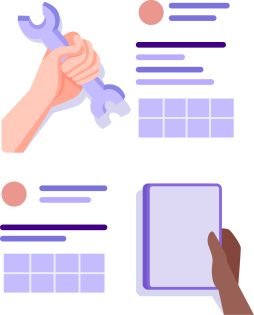Mastering Field Service Project Management: Tools, Strategies, and Innovations

Gone are the days of traditional approaches – today’s field service projects present a unique set of challenges. However, the good news is that we have at our disposal a range of cutting-edge technologies and advanced project management practices. These field service software tools not only help us navigate these challenges but also hold the key to unlocking new levels of efficiency and success. Join us as we explore the vital importance of embracing these innovations and strategies for conquering the complexities of field service project management.
Aligning Your Team for Seamless Operations
In today’s fast-paced business landscape, the significance of unifying your entire team cannot be overstated. The success of field service project management hinges on every member moving harmoniously toward a common goal. In this section, we’ll uncover the vital strategies that ensure alignment and collaboration within your team.
The digital age has brought us revolutionary software solutions that bridge the gap between office-based and field-based teams. These technologies facilitate real-time updates, enabling everyone to remain on the same page regardless of their physical location.
Enhancing Visibility and Communication in the Field
Real-time job status tracking and document updates, along with the use of communication tools like email and SMS reminders, offer numerous benefits for efficient task management in various contexts. Let’s explore these advantages in detail:
Benefits of Real-time Job Status Tracking:
- Improved Visibility: Real-time tracking provides instant visibility into the progress of tasks and projects. Team members, managers, and stakeholders can access up-to-date information, making it easier to assess the overall status of a project.
- Enhanced Accountability: With real-time tracking, individuals are more likely to take ownership of their tasks. Knowing that progress is being monitored can encourage team members to stay on track and meet deadlines.
- Effective Resource Allocation: Real-time tracking allows managers to allocate resources more effectively. They can identify bottlenecks, allocate additional resources to critical tasks, and optimize the use of available manpower and tools.
- Early Issue Detection: Real-time tracking enables prompt identification of any potential issues or delays. This allows for proactive problem-solving, preventing minor problems from escalating into major roadblocks.
- Accurate Forecasting: Access to real-time data makes forecasting and predicting project completion more accurate. This is especially important for managing client expectations and setting realistic deadlines.
- Data-Driven Decision Making: Real-time tracking provides data that can inform decision-making processes. Managers can make informed choices based on current progress, allowing for quicker adjustments to strategies and priorities.
Benefits of Document Updates:
- Version Control: Regular document updates ensure that the latest versions are always accessible. This minimizes confusion caused by outdated or conflicting information.
- Collaboration: Updated documents facilitate better collaboration among team members. Everyone is working with the same, most recent information, reducing misunderstandings and errors.
- Historical Reference: Document updates create a historical record of changes, decisions, and progress. This can be valuable for post-project analysis, audits, and learning from past experiences.
- Transparency: Keeping documents up to date promotes transparency within the team and across the organization. Team members can easily review the history of changes, making processes more accountable.
- Compliance and Auditing: For industries with regulatory requirements, regularly updated documents can help ensure compliance and simplify auditing processes.
Benefits of Communication Tools for Task Management:
- Timely Reminders: Email and SMS reminders help keep tasks on the radar, reducing the likelihood of forgetting important deadlines or steps.
- Cross-Platform Accessibility: Communication tools are accessible on various devices, enabling team members to receive reminders and updates regardless of their location.
- Personalization: Reminders can be tailored to individual preferences, enhancing their effectiveness and increasing engagement.
- Automation: These tools can automate reminder workflows, reducing the need for manual follow-ups and allowing team members to focus on higher-value tasks.
- Coordination: Communication tools facilitate coordination among team members. Reminders can ensure that everyone is aware of dependencies and upcoming milestones.
- Reduced Communication Overhead: Automated reminders can replace some routine communication, reducing the need for frequent check-ins and status updates.
Efficient Cost Tracking and Management
Tracking costs and segmenting customers and work types are crucial aspects of effective project management. Leveraging software for project costing, time management, and resource allocation adds further efficiency. Here’s a summarized overview of their significance:
Tracking Costs and Segmenting Customers/Work Types:
- Cost Tracking: Monitoring costs is essential for maintaining budget control and ensuring projects remain financially viable. Accurate cost tracking enables early identification of potential overruns and allows for timely corrective actions.
- Customer Segmentation: Segmenting customers based on characteristics like preferences, needs, and buying behaviors helps tailor services and offerings. This leads to improved customer satisfaction and better targeting of marketing efforts.
- Work Type Segmentation: Categorizing work types or tasks allows for resource allocation based on skill sets and priorities. It enhances efficiency by matching the right resources to specific tasks, leading to optimized project timelines.
Streamlining and Automating Field Service Systems
Defining systems within a job navigator offers notable advantages for streamlined workflow management. It provides clarity by structuring tasks, roles, and processes, enhancing communication and coordination. Through system definition, roles and responsibilities are well-defined, minimizing confusion and ensuring seamless task handoffs. This fosters accountability, accelerates task execution, and reduces errors.
Automation further enhances system execution efficiency. By automating routine and repetitive tasks, businesses save time and resources while maintaining consistency and accuracy. Automated systems facilitate swift task progression, reducing bottlenecks and delays. They also enable reallocation of human resources to more strategic endeavors, boosting productivity. Data-driven insights from automated systems aid decision-making, enabling adaptive strategies. Overall, the combination of well-defined systems and automation optimizes workflow, improves resource utilization, and contributes to achieving business objectives effectively.
Time Management and Information Accessibility
Centralizing data in a single, user-friendly system offers unparalleled convenience. This approach consolidates information, eliminating the need to navigate multiple platforms, saving time and reducing errors. The convenience lies in the seamless accessibility and holistic view of data, fostering informed decision-making and swift action.
Advanced job search features allow users to quickly locate relevant information, boosting productivity. Job history logs provide a comprehensive timeline of activities, aiding in tracking progress, diagnosing issues, and learning from past experiences. Real-time status updates ensure that stakeholders are well-informed about ongoing processes, promoting transparency and proactive management.
This integrated system optimizes workflow efficiency by minimizing manual data entry and promoting collaboration. The synergy of these features not only simplifies data management but also empowers users to respond promptly to changes, anticipate trends, and continuously enhance operations. Overall, the convenience offered by a comprehensive system with advanced features streamlines processes and elevates operational effectiveness.
Integrating Field Service Software with Other Systems
Integrating field service software with accounting tools such as Xero, QuickBooks, and MYOB brings substantial benefits. It streamlines operations by synchronizing customer data, job details, and financial transactions. This synergy enhances customer experience through efficient scheduling, accurate invoicing, and seamless payment processing.
Moreover, real-time data exchange between field service and accounting systems eliminates data silos, leading to improved communication between teams. This integration minimizes errors, accelerates financial reporting, and ensures a holistic view of customer interactions. Ultimately, it results in enhanced customer satisfaction, smoother processes, and optimized business operations.
Find out about FieldInsight’s integration options here.
Understanding Field Service Management Software
Field Service Management (FSM) software is a comprehensive solution that aids in organizing, optimizing, and automating field operations. It streamlines tasks like scheduling, dispatching, job tracking, and resource management, enhancing operational efficiency. Regarding costs, FSM software offers scalable pricing models based on business needs. Customization options allow tailoring to specific workflows.
Industries like HVAC, construction, utilities, and healthcare benefit from FSM, as it boosts workforce productivity, reduces response times, and improves customer satisfaction. FSM software empowers businesses to efficiently manage their field teams, reduce costs, and deliver seamless services across diverse sectors.
Field service management software: Efficient Asset Management Solution
For field service businesses, effective field service management extends to asset tracking and maintenance. Streamlined asset management ensures equipment and resources are optimally utilized, reducing downtime and operational costs. Leveraging technology, businesses can monitor asset lifecycles, track maintenance schedules, and implement predictive maintenance. This proactive approach enhances reliability, extends asset lifespan, and bolsters overall operational efficiency to enable you to deliver exceptional service.
Key Takeaways for field service operations
In conclusion, this article highlighted key tools, strategies, and innovations for effective field service project management. Real-time job tracking, document updates, and communication tools enhance visibility and collaboration. Integrating field service software with accounting tools streamlines operations. The significance of tracking costs, customer segmentation, and software automation was underscored. Continuous adaptation and embracing technology are paramount for success in field service management. Adapting to changing landscapes ensures efficient workflows and improved customer experiences.
For a comprehensive solution, we encourage you as a field service business to explore FieldInsight—a cutting-edge platform designed to optimize field service project management. Embrace these insights, stay agile, and leverage technology for seamless field operations and enhanced project outcomes.
What You Should Do Now
- Book a Demo. You’ll be in touch with an automation expert who has worked in this space for over 5 years, and knows the optimal workflow to address your needs.
- If you’d like access to free articles about managing HVAC workflows, go to our blog.
- If you know someone who’d enjoy reading this page, share it with them via email, Linkedin, Twitter, or Facebook.








